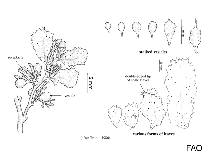Turbinaria conoides (J. Agardh) Kützing
Sea bell| Native range | All suitable habitat | Point map | Year 2050 |

|
| This map was computer-generated and has not yet been reviewed. |
| Turbinaria conoides AquaMaps Data sources: GBIF OBIS |
Upload your photos
Google image | No image available for this species;
drawing shows typical species in Sargassaceae.
Google image | No image available for this species;
drawing shows typical species in Sargassaceae.
Classification / Names Common names | Synonyms | CoL | ITIS | WoRMS
Phaeophyceae | Fucales | Sargassaceae
Environment: milieu / climate zone / depth range / distribution range Ecology
Sessile; depth range 0 - 7 m (Ref. 102126). Tropical
Distribution Countries | FAO areas | Ecosystems | Occurrences | Introductions
Indian Ocean: from Iran to Madagascar, including the Persian Gulf, Aldabra, Seychelles, Mauritius and Réunion, east to India and south to Indonesia including Laccadive and Andaman Islands; Pacific Ocean: from China to the South China Sea south to Queensland, Australia including Federated States of Micronesia, Solomon Islands and Fiji, east to the Samoan Archipelago.
Length at first maturity / Size / Weight / Age
Maturity: Lm ? range ? - ? cm
Short description Morphology
Thalli erect, yellowish brown to dark brown in colour, attached by coarse branched holdfasts to rocky substrate, forming thick, huge colonies. Axes terete, muricate at the basal portion. Leaves are 6 to 12 mm long, consisting of a stalk, small vesicles and an expanded distal marginal blade outlined by coarse teeth; leaves triangular in outline or irregularly rounded in surface view; 3.5 to 9.0 mm across, sometimes deeply cut on one side, the cut often reaching the vesicle. Receptacular clusters 3 to 10 mm long, generally shorter and attached to the stalk of the leaves at 1/4 the distance from the main axis. This species is easily distinguished by its lax branched thalli, numerous branches, and small turbinate leaves with a length of about 1 cm or less. Thalli up to 1.5 m in height (Ref. 80758).
Used for human consumption, as fertilizer and insect repellant; contains minerals (Ca, K, Mg, Na, Cu, Fe, Zn); source of algin, tannins and phenols (Ref. 80758). Thrives mostly on sandy coralline bottoms on reef portions which are not exposed to excessive water turbulence; usually in shallow lagoons or tidepools in subtidal habitats protected from strong wave action (Ref. 80758).
Life cycle and mating behavior Maturity | Reproduction | Spawning | Eggs | Fecundity | Larvae
Main reference
References | Coordinator | Collaborators
Guiry, M.D. and G.M. Guiry. 2009. (Ref. 80701)
IUCN Red List Status (Ref. 130435)
CITES status (Ref. 108899)
Not Evaluated
CMS (Ref. 116361)
Not Evaluated
Threat to humans
Harmless (Ref. 80758)
Human uses
Fisheries: commercial
| FishSource |
Tools
More information
Internet sources
BHL | BOLD Systems | CISTI | DiscoverLife | FAO(Publication : search) | Fishipedia | GenBank (genome, nucleotide) | GloBI | Gomexsi | Google Books | Google Scholar | Google | PubMed | AlgaeBase | Tree of Life | Wikipedia (Go, Search) | Zoological Record
Estimates based on models
Preferred temperature
(Ref. 115969): 24.6 - 29.3, mean 28.4 (based on 3837 cells).



